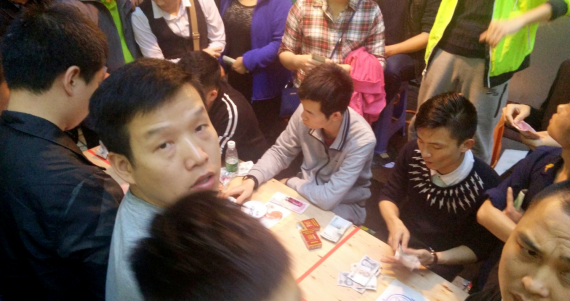Fever-Detecting Goggles and Disinfectant Drones: Countries Turn to Tech to Fight Coronavirus — Wall Street Journal
–

–

–
Drones spray disinfectant over South Korea. Police wear thermal imaging goggles to detect fevers in China. And a chatbot fields coronavirus questions in Australia.
The tech industry has long touted how ubiquitous connectivity, flashy gadgets and big data can improve people’s lives. The novel coronavirus epidemic is putting that bold promise to the test.
Health officials across Asia-Pacific, home to the first waves of virus contagion, have sought to repurpose existing technology to combat the fast-spreading virus. They are using smartphone-location tracking to piece together movements of suspected cases, developing government-run apps to monitor individuals’ health and keeping an eye on people’s temperature in the street with thermal goggles.
These new responses supplement traditional tactics such as quarantining sick people and canceling mass public events. But the tech-savvy tactics have yet to demonstrate broadly whether they are more game-changer than gimmick. Still, countries elsewhere might look to these solutions as the epidemic spreads.
The global number of confirmed coronavirus cases rose above 110,000 on Monday, according to data compiled by Johns Hopkins University, with infections found in 108 countries and regions.
In South Korea, the country hit hardest by the virus after China and Italy, the government rolled out a “Self-Quarantine Safety Protection” tracking app to keep digital eyeballs on the roughly 30,000 people officials told to stay home for two weeks. If a person brings their phone out of the permitted area, a mobile alert gets beamed to the individual and their government case officer.
The technology comes with a rub: It isn’t available on Apple Inc.’s iPhones until March 20. The app only works on handsets that run Google’s Android operating system used by hometown brands, Samsung Electronics Co. and LG Electronics Inc. Voluntary downloads since Saturday’s launch have been low, a government spokesman said.High-Speed Trains, International Flights: How the Coronavirus Spread
In Singapore, a Southeast Asian country hit in the early stages of the virus outbreak, health officials are asking citizens to monitor their own movements with the QR code, the black-and-white bar code used for mobile payments. A scan of these codes, found in taxis, office lobbies, tourist attractions and colleges, bring people to a webpage where they are asked to input their names, contact details and on occasion declare their health status. The voluntary scans allow authorities to reverse engineer a citizens’ whereabouts in case they fall ill or come into contact with a patient.
In Singapore’s Nanyang Technological University, where students, staff and visitors scan such bar codes to leave a digital trail of the locations they visit in the university, the data helped the university probe whether any of their 33,000 students had come into contact with a cleaning contractor who worked in the school after that person was diagnosed with Covid-19, said Tan Aik Na, a senior vice president at the university.
The system has limits. Claudia Thong, a 21-year-old Singapore university student, scans QR codes pasted on the front doors and interiors of classrooms each time she attends lessons. Some students, however, can’t be bothered to scan the codes, she said. Faculty and staff have been asked to remind their students and guests to perform the QR code check-in, the university said in a statement.
Australia’s health department directs worried citizens to a virtual assistant named “Sam.” But inquiries for “coronavirus” go unrecognized, with the site suggesting the correct spelling is the two-word, “corona virus.” A follow-up question about anxieties relating to “corona virus” produced suggestions that had nothing to do with the respiratory illness.
The chatbot will soon be updated to refer people to Covid-19 resources, an Australian health-department spokesman said.
In China, where the largest Covid-19 outbreak has occurred, cities have deployed a variety of eye-catching technologies to diagnose and contain illness. Through measures such as social distancing and isolation, China has managed to limit the outbreak mostly to Hubei province, where the infectious disease emerged and where the majority of cases have occurred.
Unmanned aerial vehicles, typically used to spot forest fires or for police surveillance, can now scan crowds in China and spot someone hundreds of feet away running a fever, said Kellen Tse, deputy general manager for Shenzhen Smart Drone UAV Co., a drone company working with two Chinese provinces. The drone, which uses thermal imaging, sends alerts about those unwell to on-the-ground officials.
“China is unlike other countries,’ Mr. Tse said. “We have a large population, that’s why we’ve turned to technology to be more efficient.”
In Shanghai, digital devices are attached to the doors of those sequestered, according to the city’s state-television channel. People are allowed to go out to empty their trash and pick up deliveries, but unauthorized door movements trigger an alarm to the neighborhood police station, a policewoman told the broadcaster in an interview.
Chinese technology firm Baidu Inc. said this month that it helped develop an algorithm for Beijing subway officials to single out commuters not wearing masks. The image-recognition algorithm, which Baidu developed and tested seven days after a request from the city’s metro administration, runs on the video feeds from subway cameras and flags individuals without a mask or who don’t wear one properly.
Shenzhen, China’s tech-manufacturing center, requests that drivers entering the city scan a QR code and leave their contact details and travel history. Police officers wear thermal helmets and goggles to identify pedestrians who may be unwell, the Shenzhen government said on social media.
But the new-age tactics have their limitations. Commercial drones can only fly for about 20 minutes before needing a lengthy recharge, and the tech-heavy defenses are expensive, said Peter Fuhrman, a Shenzhen resident and chairman of China First Capital, a boutique investment bank. He credits the conventional response of the masses of volunteers and paid monitors deployed in Chinese neighborhoods with thwarting the virus.
“Fittingly, people, not machines, made all the difference here,” said Mr. Fuhrman, who has stayed in Shenzhen since the country’s outbreak began in January.
In South Korea’s hard-hit city of Daegu, private drone companies have been deployed to help disinfect public places at the local government’s request. A single drone can load around 2.5 gallons of disinfectant and spray an area of up to 105,000 square feet—or about the size of a typical Walmart store.
“It takes about 10 to 12 minutes to use it all up,” a Daegu city official said.
–
–




























